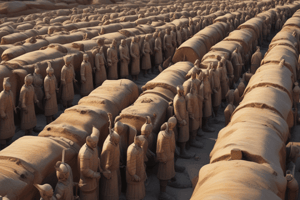Podcast
Questions and Answers
What was the primary purpose of the Terracotta Army?
What was the primary purpose of the Terracotta Army?
To protect Emperor Qin Shi Huang in the afterlife.
How many workers were involved in the construction of the Terracotta Army?
How many workers were involved in the construction of the Terracotta Army?
Over 700,000 workers.
What philosophical concepts flourished during the Zhou Dynasty?
What philosophical concepts flourished during the Zhou Dynasty?
Confucianism and Daoism.
During which years was the Terracotta Army constructed?
During which years was the Terracotta Army constructed?
What concept introduced during the Zhou Dynasty justified the rule of subsequent dynasties?
What concept introduced during the Zhou Dynasty justified the rule of subsequent dynasties?
What key contributions did the Xia Chāo Dynasty make to Chinese agriculture and society despite its historical skepticism?
What key contributions did the Xia Chāo Dynasty make to Chinese agriculture and society despite its historical skepticism?
In terms of Confucian thought, what are the five key relationships that structure society?
In terms of Confucian thought, what are the five key relationships that structure society?
Explain the significance of the Shang Dynasty in Chinese history and its contributions.
Explain the significance of the Shang Dynasty in Chinese history and its contributions.
What philosophy is expressed through Daoism, and what are its core principles?
What philosophy is expressed through Daoism, and what are its core principles?
Identify the major contributions of the Qin Dynasty to the unification of China.
Identify the major contributions of the Qin Dynasty to the unification of China.
Flashcards are hidden until you start studying
Study Notes
Contributions to Chinese History
- Reunification of China: Pivotal in the establishment of strong centralized states and cultural unity following periods of fragmentation.
- Grand Canal Construction: Facilitated trade and transportation across different regions, promoting economic integration.
- Confucian Thought:
- Central concepts: ren (humaneness), yi (righteousness), li (propriety).
- Advocates five key relationships for a structured society: ruler-subject, father-son, husband-wife, elder brother-younger brother, friend-friend.
Xia Dynasty (2070-1600 BC)
- Traditionally recognized as the first Chinese dynasty, credited to Yu the Great for flood control methods.
- Limited archeological evidence raises skepticism about historicity, leading to debates on its mythic nature.
Shang Dynasty (1600-1050 BC)
- Acknowledged as the first verified dynasty with ample archaeological findings.
- Noted for bronze technology, oracle bone writing system, and advancements in mathematics and astronomy.
Zhou Dynasty (1046-256 BC)
- Introduced the Mandate of Heaven, influencing justifications for rule across dynasties.
- Longest-lasting dynasty, fostering significant philosophies including Confucianism and Daoism.
- Divided into Western Zhou (1046-771 BC) and Eastern Zhou (771-256 BC) with cultural and technological progress.
Qin Dynasty (221-206 BCE)
- Marked as the first unified Chinese empire; established a centralized government.
- Key achievements: construction of the Great Wall, standardization of writing, weights, and measures.
- Notable for the Terracotta Army, created to protect Emperor Qin Shi Huang in the afterlife.
Southern and Northern Dynasties (420-589 CE)
- Era characterized by the spread of Buddhism and Daoism.
- Notable for advancements in arts, science, and technology amidst political fragmentation.
Tang Dynasty (618-907 CE)
- Represented a golden age for Chinese culture, particularly in art and poetry.
- Expansion of trade, especially the Silk Road, and enhancement of civil service examination systems.
Kublai Khan and Mongol Rule
- Genghis Khan initiated Mongol conquests starting in 1211, capturing key Jin Dynasty territories.
- Kublai Khan completed the conquest and established the Yuan Dynasty (1271-1368 CE), claiming imperial authority in China.
Empress Wu Zetian (690-705 CE)
- Only female monarch in Chinese history, ruled during the Tang Dynasty.
- Effective governance marked by political stability and empire expansion, despite societal gender challenges.
Ming Dynasty (1368-1644 CE)
- Known for the construction of the Forbidden City and significant maritime exploration led by Zheng He.
- Efforts in restoring and expanding the Great Wall for defense.
Qing Dynasty (1644-1912 CE)
- Last imperial dynasty in China; notable for territorial expansion and modernization.
- Experienced interaction with Western powers leading to the eventual fall of the imperial system.
Language and Tone in Mandarin
-
Five Intonations:
- First Tone: High, flat pitch (e.g., 妈, mā).
- Second Tone: Rising pitch, akin to inquisitive intonation (e.g., 吗, ma).
-
Numbers in Pinyin:
- 一 (yī) - one
- 二 (èr) - two
- 三 (sān) - three
- 四 (sì) - four
- 五 (wǔ) - five
- 六 (liù) - six
- 七 (qī) - seven
- 八 (bā) - eight
Republic of China (1912-1949 CE)
- Ended the imperial system; characterized by modernization efforts, internal conflicts, and external threats including the Japanese invasion.
People’s Republic of China (1949 onwards)
- Established following the Chinese Civil War, shaping modern Chinese governance and international relations.
Studying That Suits You
Use AI to generate personalized quizzes and flashcards to suit your learning preferences.




